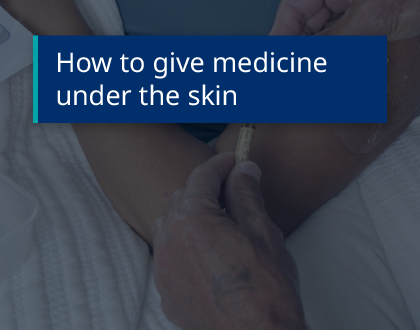Published: 23 August 2024
Transcript
[Music plays]
[Text on screen] Video 3 - How to give medicine under the skin. caring@home.
>>Narrator (female voice over): In this video we will show you how to give medicine under the skin.
The nurse will have put a cannula under the skin of the person you are caring for. This is where the medicine goes in.
[Text on screen] Step 1 – Check the site
>>Narrator (female voice over): Before giving the medicine, look at the insertion site where the cannula enters the skin.
- Look for:
- Swelling or a hard lump
- Tenderness
- Bruising or
- Leakage
[Text on screen] Look for:
- Swelling or a hard lump
- Tenderness
- Bruising or
- Leakage
>>Narrator (female voice over): If you notice any of these things, call the nurse. Don’t give any medicine through the cannula until you get advice from the nurse. If the area looks ok, then you can go ahead.
[Text on screen] Step 2 – Wash your hands
>>Narrator (female voice over): Wash your hands.
[Text on screen]Step 3 - Check you have the correct medicine
>>Narrator (female voice over):
- Get the correct medicine syringe out of the fridge.
- Check the syringe label to make sure you have the right medicine for the symptom your person is experiencing.
- As a double check, match the label against the “What medicine to give” wall chart.
- Warm the medicine syringe in your hand
- Put it in a clean container
- Get a flush syringe and put it in the container
- If the person has more than one symptom, you might have to give more than one medicine. It is ok to give more than one medicine into the cannula, one after the other.
[Text on screen] Step 4 - Take medicine and flush syringes to the person
>>Narrator (female voice over): Then take the medicine syringe, flush syringe and step-by-step guide to the person.
- Explain to the person that you are going to give the medicine.
- Tell the person that they may feel the medicine going in and that’s OK. Tell them it should not hurt. And if it does hurt, they should tell you.
[Text on screen] Step 5 - Twist the cap off the medicine syringe
>>Narrator (female voice over): Twist the cap off the medicine syringe.
[Text on screen] Step 6 - Push and twist the medicine syringe onto the cannula
>>Narrator (female voice over): Hold the yellow Y arm of the cannula. Push the syringe onto the connector on the cannula. Twist the syringe until it is tight.
[Text on screen] Step 7 - Give all the medicine slowly
>>Narrator (female voice over): Slowly push the plunger of the syringe until there is no medicine left in the syringe.
[Text on screen] Step 8 - Twist the empty syringe off
>>Narrator (female voice over): Twist the empty syringe off and put it back in the container.
[Text on screen] Step 9 - Repeat steps to give the flush
>>Narrator (female voice over): Now repeat these steps to give the flush.
[Text on screen] Step 10 - Check the connector is tight
>>Narrator (female voice over): Hold the yellow Y arm of the cannula and twist the connector to make sure it is tight.
[Text on screen] Step 11 - Re-check the site
>>Narrator (female voice over): Check the site again.
Look for:
- Swelling or a hard lump. There may be a small lump under the skin where medicine went in. And that’s Ok. It will go away.
- Tenderness or pain
- Bruising or
- Leakage
[Text on screen] Look for:
- Swelling or a hard lump
- Tenderness
- Bruising or
- Leakage
>>Narrator (female voice over): If you notice any of these things, call the nurse.
[Text on screen] Step 12 – Wash your hands.
>>Narrator (female voice over): Wash your hands again.
[Text on screen] Step 13 – Fill in the Medicines diary
>>Narrator (female voice over): The final step after giving the medicine is to fill in the Medicines diary.
Fill in:
- The date
- The time
- The name of the medicine
- The number that matches how the person felt before the medicine was given.
[Text on screen] Step 14 – Wait 20 minutes.
>>Narrator (female voice over): Wash your hands again.
[Text on screen] Step 15 – Fill in the Medicines diary
>>Narrator (female voice over): Then fill in the Medicines diary again by writing the new number that matches how the person feels.
If the medicine has not helped the person feel better, call the nurse.
[Text on screen] caring@home. caringathomeproject.com.au
caring@home is funded by the Australian Government and led by Brisbane South Palliative Care Collaborative
[Music ends]
End of transcript

- Audience General public
- FormatVideo
- LanguageEnglish
- Last updated11 March 2025
Details
This resource is part of our community palliative care resources box.
